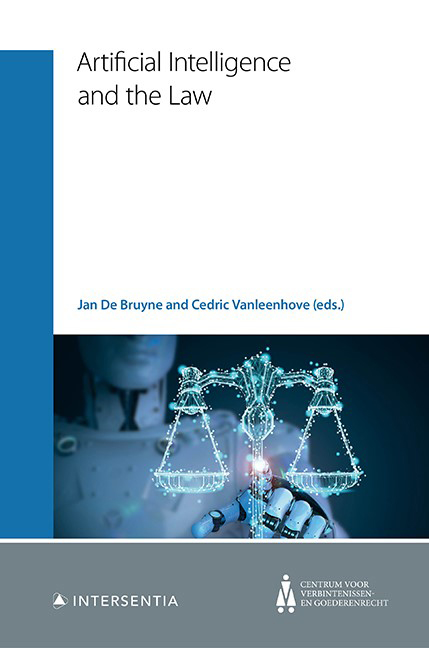Book contents
- Frontmatter
- Contents
- Foreword
- Contributing Authors
- Chapter 1 Basic Concepts of AI for Legal Scholars
- Chapter 2 Different Models of Innovation and Their Relation to Law
- Chapter 3 Setting the Scene: On AI Ethics and Regulation
- Chapter 4 Quantitative Legal Prediction: the Future of Dispute Resolution?
- Chapter 5 AI Arbitrators … ‘Does Not Compute’
- Chapter 6 AI through a Human Rights Lens. The Role of Human Rights in Fulfilling AI’s Potential
- Chapter 7 Killer Robots: Lethal Autonomous Weapons and International Law
- Chapter 8 AI and Data Protection: the Case of Smart Home Assistants
- Chapter 9 AI and IP: a Tale of Two Acronyms
- Chapter 10 Tax and Robots
- Chapter 11 Robotisation and Labour Law. The Dark Factory: the Dark Side of Work?
- Chapter 12 The Hypothesis of Technological Unemployment Caused by AI-Driven Automation and its Impact on Social Security Law
- Chapter 13 AI in Belgian Contract Law: Disruptive Challenge or Business as Usual?
- Chapter 14 Tort Law and Damage Caused by AI Systems
- Chapter 15 Insurance Underwriting on the Basis of Telematics: Segmentation and Profiling
- Chapter 16 AI and Creditworthiness Assessments: the Tale of Credit Scoring and Consumer Protection. A Story with a Happy Ending?
- Chapter 17 AI and the Consumer
- Chapter 18 Robots and AI in the Healthcare Sector: Potential Existing Legal Safeguards Against a(n) (Un)justified Fear for ‘Dehumanisation’ of the Physician-Patient Relationship
Chapter 7 - Killer Robots: Lethal Autonomous Weapons and International Law
Published online by Cambridge University Press: 26 May 2021
- Frontmatter
- Contents
- Foreword
- Contributing Authors
- Chapter 1 Basic Concepts of AI for Legal Scholars
- Chapter 2 Different Models of Innovation and Their Relation to Law
- Chapter 3 Setting the Scene: On AI Ethics and Regulation
- Chapter 4 Quantitative Legal Prediction: the Future of Dispute Resolution?
- Chapter 5 AI Arbitrators … ‘Does Not Compute’
- Chapter 6 AI through a Human Rights Lens. The Role of Human Rights in Fulfilling AI’s Potential
- Chapter 7 Killer Robots: Lethal Autonomous Weapons and International Law
- Chapter 8 AI and Data Protection: the Case of Smart Home Assistants
- Chapter 9 AI and IP: a Tale of Two Acronyms
- Chapter 10 Tax and Robots
- Chapter 11 Robotisation and Labour Law. The Dark Factory: the Dark Side of Work?
- Chapter 12 The Hypothesis of Technological Unemployment Caused by AI-Driven Automation and its Impact on Social Security Law
- Chapter 13 AI in Belgian Contract Law: Disruptive Challenge or Business as Usual?
- Chapter 14 Tort Law and Damage Caused by AI Systems
- Chapter 15 Insurance Underwriting on the Basis of Telematics: Segmentation and Profiling
- Chapter 16 AI and Creditworthiness Assessments: the Tale of Credit Scoring and Consumer Protection. A Story with a Happy Ending?
- Chapter 17 AI and the Consumer
- Chapter 18 Robots and AI in the Healthcare Sector: Potential Existing Legal Safeguards Against a(n) (Un)justified Fear for ‘Dehumanisation’ of the Physician-Patient Relationship
Summary
INTRODUCTION
1. According to Isaac Asimov's 1942 sci-fi story Runaround, the ‘First Law of Robotics’ prescribes that ‘a robot may not injure a human being or, through inaction, allow a human being to come to harm’. The Second law states that ‘a robot must obey the orders given it by human beings except where such orders would conflict with the First Law’. Technology has come a long way since the heyday of sci-fi books and films about robot overlords and robotised weaponry. And while science-fiction literature and Hollywood have surely fuelled the imagination of the general audience, our civilisation is nowhere near robot domination yet. Nevertheless, technological developments in the methods and means of warfare brew at the horizon like an ever more ominous cloud, and the question of whether humanity needs its own Laws of Robotics becomes increasingly prominent.
2. As this book amply shows, the potential of robots and AI in law is tremendous. It certainly seems that in many fields of human activity, this great potential is of a largely beneficial kind. Efficiency, autonomy and an unmatched computational power promise sizeable gains in an array of legal domains. In international law, and more particularly in the realm of the conduct of hostilities, there is not as much space for unbridled optimism. This chapter will attempt to shed some light on important questions of international law when dealing with robots. First, the reader is introduced to the basic concepts of international humanitarian law and several prima facie concerns regarding their relationship to LAWs, in particular the principles of distinction and the prohibition of superfluous injury or unnecessary suffering (part 2). We then explore the legal aspects of LAWs relating to two themes: the authority awarded to machines and automated decision-making processes on wounding and/or killing humans in an armed conflict, as well as the processes and procedural safeguards behind targeting and engagement choices (part 3). This is followed by a briefing on current applications of LAWs and their foreseeable developments, with a particular focus on the US and China as the two military actors most advanced in developing such technology (part 4).
- Type
- Chapter
- Information
- Artificial Intelligence and the Law , pp. 151 - 172Publisher: IntersentiaPrint publication year: 2021
- 1
- Cited by



